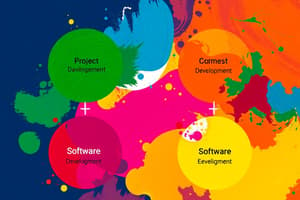Podcast
Questions and Answers
What does the Waterfall Model primarily emphasize in its software development approach?
What does the Waterfall Model primarily emphasize in its software development approach?
- Flexible requirements that evolve over time
- Development through multiple iterations
- Continuous testing throughout development
- Completion of each phase before moving to the next (correct)
Which model emphasizes both validation and verification at every stage of development?
Which model emphasizes both validation and verification at every stage of development?
- Prototype Model
- V-Model (correct)
- Incremental Model
- Iterative Model
In which model are projects developed and delivered in smaller, manageable portions?
In which model are projects developed and delivered in smaller, manageable portions?
- Iterative Model
- Waterfall Model
- V-Model
- Incremental Model (correct)
What is the primary focus of the Iterative Model?
What is the primary focus of the Iterative Model?
Which model functions by creating a prototype to gather user feedback and quality requirements?
Which model functions by creating a prototype to gather user feedback and quality requirements?
What is the first phase of the System Development Life Cycle (SDLC)?
What is the first phase of the System Development Life Cycle (SDLC)?
During which SDLC phase do organizations analyze current procedures and determine system requirements?
During which SDLC phase do organizations analyze current procedures and determine system requirements?
What is produced during the Design phase of the SDLC?
What is produced during the Design phase of the SDLC?
Which phase involves coding, testing, and installing the information system?
Which phase involves coding, testing, and installing the information system?
What is the final phase of the SDLC called?
What is the final phase of the SDLC called?
Which of the following is NOT part of the SDLC phases?
Which of the following is NOT part of the SDLC phases?
Which of the following best describes modern life cycle models in software development?
Which of the following best describes modern life cycle models in software development?
What distinguishes logical design from physical design in the SDLC?
What distinguishes logical design from physical design in the SDLC?
Which outcome occurs during the Planning phase of the SDLC?
Which outcome occurs during the Planning phase of the SDLC?
What is a primary advantage of the Rapid Application Development (RAD) methodology?
What is a primary advantage of the Rapid Application Development (RAD) methodology?
What is a defining characteristic of the Agile Model?
What is a defining characteristic of the Agile Model?
Which methodology limits work-in-progress to improve efficiency?
Which methodology limits work-in-progress to improve efficiency?
Which of the following methodologies combines development and operations?
Which of the following methodologies combines development and operations?
What approach does the Spiral Model incorporate?
What approach does the Spiral Model incorporate?
What is a feature of Scrum methodologies?
What is a feature of Scrum methodologies?
Modern life cycle models aim to address which of the following challenges?
Modern life cycle models aim to address which of the following challenges?
Flashcards
Waterfall Model
Waterfall Model
A structured approach to software development where each phase (requirements, design, implementation, testing, deployment, and maintenance) must be completed before moving to the next.
V-Model
V-Model
A linear approach like the Waterfall model, but emphasizes testing and verification at each development stage.
Incremental Model
Incremental Model
A flexible approach where the project is divided into smaller segments, each segment is developed and delivered individually, providing an early working product.
Iterative Model
Iterative Model
Signup and view all the flashcards
Prototype Model
Prototype Model
Signup and view all the flashcards
Modern Life Cycle Models
Modern Life Cycle Models
Signup and view all the flashcards
Rapid Application Development (RAD)
Rapid Application Development (RAD)
Signup and view all the flashcards
Agile Model
Agile Model
Signup and view all the flashcards
Scrum
Scrum
Signup and view all the flashcards
Kanban
Kanban
Signup and view all the flashcards
DevOps
DevOps
Signup and view all the flashcards
Spiral Model
Spiral Model
Signup and view all the flashcards
Modern Life Cycle Models (characteristics)
Modern Life Cycle Models (characteristics)
Signup and view all the flashcards
SDLC (System Development Life Cycle)
SDLC (System Development Life Cycle)
Signup and view all the flashcards
Planning
Planning
Signup and view all the flashcards
Analysis
Analysis
Signup and view all the flashcards
Design
Design
Signup and view all the flashcards
Implementation
Implementation
Signup and view all the flashcards
Maintenance
Maintenance
Signup and view all the flashcards
Flexibility in SDLC
Flexibility in SDLC
Signup and view all the flashcards
Customizable SDLC
Customizable SDLC
Signup and view all the flashcards
Study Notes
Chapter 2: System Development Life Cycle Models
- This chapter focuses on System Development Life Cycle (SDLC) models
- Learning objectives include identifying traditional SDLC models, explaining differences between models, and listing SDLC stages.
2.1 Traditional Life Cycle Models
- Traditional Life Cycle Models are structured methods used in software and system engineering
- They follow a linear or sequential process with clearly defined stages
- Examples include:
- Waterfall Model: A linear approach; each phase (Requirements, Design, Implementation, Testing, Deployment, and Maintenance) must be completed before moving to the next.
- V-Model (Validation and Verification): Extends the Waterfall model by emphasizing testing and verification at each development stage.
- Incremental Model: Divides the project into smaller segments; allows portions to be developed and delivered incrementally
- Iterative Model: Focuses on refining and revisiting processes; repeated cycles improve the system at each iteration
- Prototype Model: Involves creating an initial prototype to gather user feedback and refine requirements
2.1 Traditional Life Cycle Models (Continued)
-
A diagram illustrating the Waterfall model shows the sequential flow from Requirement Analysis to System Design, Implementation, Testing, Deployment, and Maintenance.
-
A diagram illustrating the V-Model shows the verification and validation phases at each stage of development in a V-shape.
-
A diagram illustrating the Incremental model shows the project divided into smaller segments, delivered incrementally. Steps in the cycle are repeated for each iteration.
-
A diagram illustrating the Iterative model shows repeated cycles focusing on refining and improving the system at each iteration.
-
A diagram illustrating the Prototype model shows the steps for requirement gathering and building the prototype.
2.2 Modern Life Cycle Models
- Modern Life Cycle Models are contemporary approaches to software development
- They emphasize flexibility, adaptability, iterative progress to account for dynamic business needs and evolving technologies
- These models contrast with traditional ones via continuous improvement, collaboration, and faster delivery
- Examples include:
- Rapid Application Development (RAD): Emphasizes speed, flexibility, and iterative development to quickly deliver a working product. Minimizes planning and maximizes user involvement
- Agile Model: A flexible and iterative approach that promotes collaboration, customer feedback, and small, rapid releases
- Scrum: A subset of Agile focused on short development cycles (sprints) with defined roles like Scrum Master and Product Owner
- Kanban: A lean methodology emphasizing visual workflows and limiting work-in-progress to improve efficiency
- DevOps: Combines development and operations to enhance collaboration, automate processes, and enable continuous delivery and integration
- Spiral Model: Combines iterative development with a risk-driven approach, repeatedly passing through planning, design, build, and testing phases.
2.3 Overview SDLC Stages
- Traditional SDLC methodology used to develop, maintain, and replace information systems
- Consists of five phases:
- Planning and Selection
- Analysis
- Design
- Implementation
- Maintenance
- Phases are not necessarily sequential
- Each phase has a specific outcome and deliverable
- Individual companies may adapt lifecycles
2.3 Overview SDLC Stages (Continued)
- Planning: Determines an information system's total needs and prioritizes them
- Analysis: Studies current procedures and information systems, determines requirements, generates design options and recommends the best alternative.
- Design: Describes the recommended solution, creating logical and physical specifications. Logical design defines all functional features; physical design specifies the technology-specific details.
- Implementation: Codes, tests, installs and supports the new system within the organization.
- Maintenance: Monitors the information system; makes changes to resolve user issues reflecting evolving business conditions to maintain running and useful systems. Programmer adjustments reflect user needs and business changes.
Additional Information
- A table outlining the products, outputs, and deliverables for each SDLC phase are provided
- Diagrams illustrate the components of the Waterfall, V-Model, Incremental, Iterative, and Prototype models, along with the Evolutionary and systems development lifecycle models.
Studying That Suits You
Use AI to generate personalized quizzes and flashcards to suit your learning preferences.




